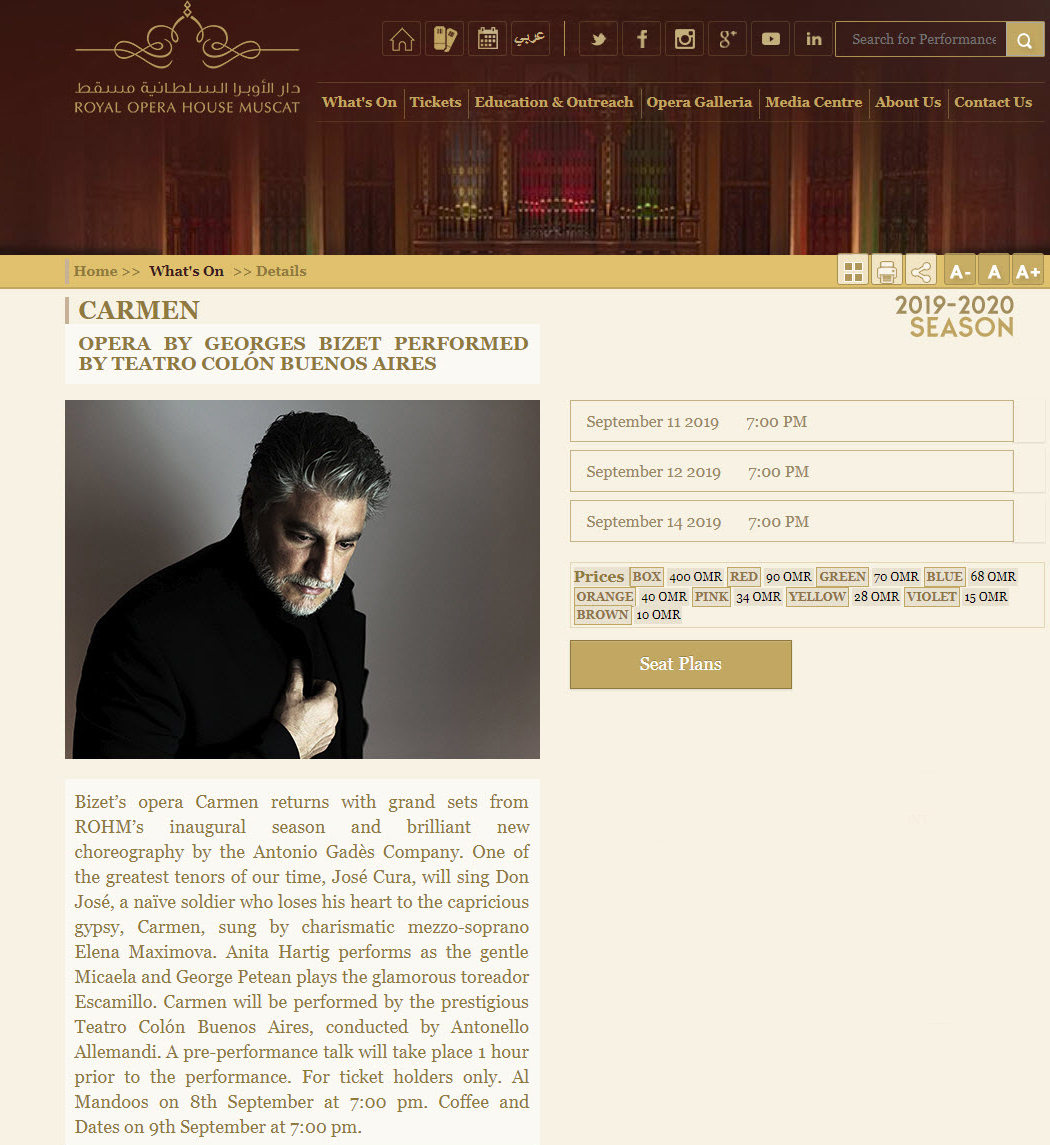
Bravo Cura
Celebrating José Cura--Singer, Conductor, Director
Operas: Carmen
Muscat, Oman

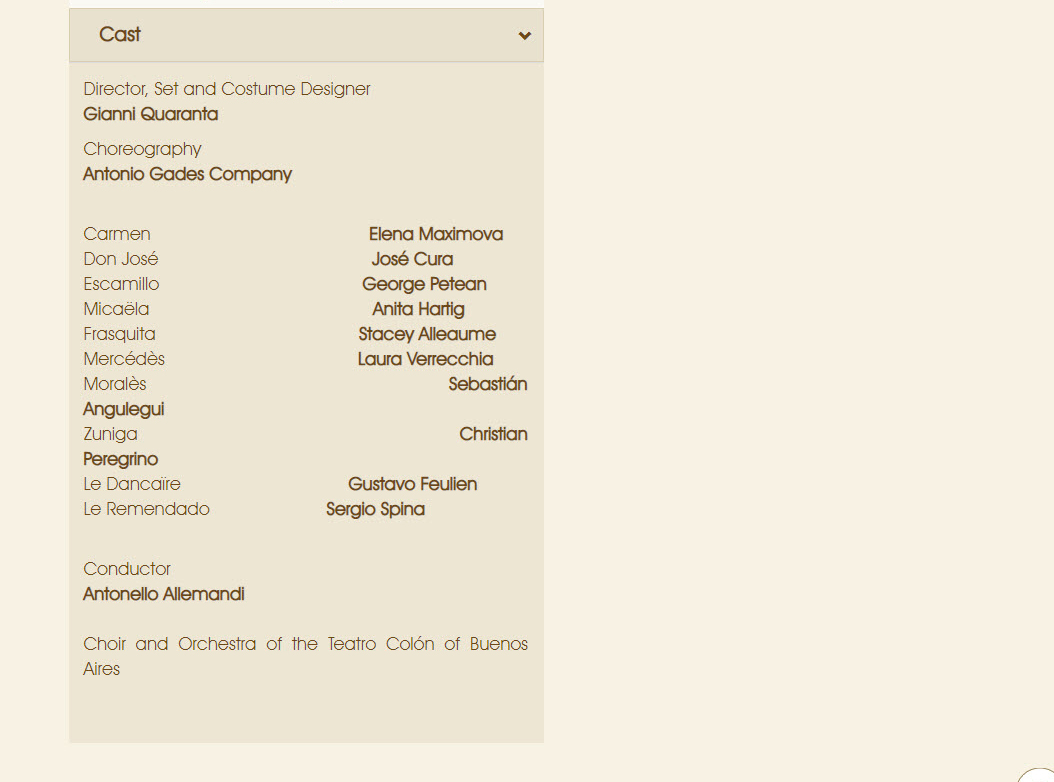

|
[Excerpt]
Muscat:
An Oscar winning art director has praised His Majesty Sultan Qaboos
bin Said for bringing the Royal Opera House to Muscat and connecting
everyone from across the world through it. Returning to Oman after a gap of eight years, Quaranta is the director, set and costume designer for one of the most frequently performed operas in the classical canon, Carmen, which came to the ROHM as a specially commissioned production for the landmark Inaugural Season in 2011. [...]
Speaking about how he feels about reconnecting with the lead performer
– José Cura, who will appear as Don José - Quaranta said that no
one better than him could have done it.
|
Reviews
|
Note: this is an excerpt. Please read David's complete, fascinating, and insightful review athttps://operawire.com/royal-opera-house-muscat-2019-20-review-carmen/
Royal Opera House Muscat Review: Carmen
Buoyed by Vibrant Artists, Gianni Quaranta’s Production is Glorious To Behold
OperaWire David Salazar
(Photo credit: Khalid AlBusaidi / ROHM) This review is for performances on Sept. 11 and 14, 2019.
Writing a review after an initial performance of any run is a challenging proposition. You are essentially recording your views on a first impression without really getting a chance to see the full picture. There are many reasons why this is the case, but in taking on some productions, it is truly possible to get a more panoramic view of a production and its development to fully understand the artistic intentions. This was undeniably the case with the Royal Opera House Muscat’s production of Bizet’s “Carmen,” which opened on Sept. 11, 2019 and featured two subsequent performances over three nights. OperaWire saw the opening and closing night shows, which were completely different in how they told the story. The production, a revival of Gianni Quaranta’s vision, is a visual spectacle that rivals the imperious opera house itself and its own imposing elegance and vibrancy. Quaranta’s set design is Zeffirelli-esque in its incredible detail, immersive nature, and adherence to a traditional approach to the French opera.
Glorious Hyper-RealismAs audiences entered the hall, the stage represented the outside of a bullring with three archways in the center. During the overture, a few towns people, dressed in Spanish garb of the 1800s would walk to and fro. Immediately, this established the world of the story, but also emphasized the motif of the bullring as central to the story. It also teased the opera’s final scene in which José and Carmen’s fateful confrontation would take place in the exact place where the opera started. The bullring would then open up to reveal the distinct locations of the four acts, each opening frame an assault on the senses, in the best of ways. For Act one, we got to see the town square, with a glorious backdrop that rendered the town expanding into the distance. In Act two, Lillas Pastias’ Inn was rendered gloriously with chiaroscuro lighting. Perhaps the most incredible image to materialize when the bullring parted was the two level mountains of Act three with caves and alcoves embedded to create a sense of increased claustrophobia. Set against blue lighting, the coldness of this environment only furthered the increased distance between Carmen and José. Finally, Act four opened up to the inside of the bull ring itself with a massive chorus seated all over. The parade itself entered, with horses from the Omani Sultan’s own stable joining in, adding to the sense of spectacle and hyper-realism at hand; the varied color of the distinct wardrobes added to this overwhelming experience. The set then closed up again for the final confrontation, emphasizing the circular nature of the story. [...]
The Tragedy of Don José But the most questionable aspect of the production was the narrative shift to portraying the opera globally as the tragedy of Don José. As the overture shifts to the Andante moderato in A minor, a man limps on stage, seemingly running away from some oncoming attacker. As he nearly makes his way from stage left to right, his attacker reveals himself – Don José. The opera’s tragic hero suddenly runs across the stage, behind the columns and stabs the man. The overture comes to an end with that image, suddenly transforming the entire story and subverting audience expectations in a truly uncomfortable way. Per Quaranta’s program notes, José is wanted for this murder and thus enlists in the army to redeem himself and show himself to be a man of honor. As such, the opera’s formal narrative becomes, as Quaranta notes, “a drama about the impossibility of escaping one’s temperament.” We get closer looks at José’s monstrous behavior as he impulsively kills Zuñiga at the end of Act two and abuses Carmen right from the start of their reunion in Act two; his famed aria “La fleur que tu m’avais jetée” is not a declaration of love but an apology after having grabbed Carmen and thrown her violently to the floor. It only goes downhill from there. A dark vision of José is in and of itself not problematic, especially in the #metoo mileu. Tenor José Cura, who interpreted the character, noted in conversation that he sees José’s love for Carmen as nothing more than sexual awakening for a teenager and that his possession arises not from a sense of love, but machismo insecurity. Quaranta’s argument, also expressed in conversation, furthers this assessment of José as an exploration of a social attitude, noting that the character’s murderous tendencies needed to come from somewhere and as depicted in the opera, it is hard to believe that a man of virtue could stoop so low without antecedents of such behavior. Furthermore, by being forgiven for his crime, he was being supported by the social structure. Finally, he pointed to Merimée’s darker vision of the character in the original novella. And this is all well and fine, but it comes at a cost – Carmen. Any potential “love” between them does not exist in this production. The opera itself doesn’t present many chances for creating a credible sense of connection between the two and the choices here only furthered the audience from any such notion. Quaranta has explained that Omani regulations forbid that he have the characters engage in any suggestive behavior, with even kissing completely off limits. This undeniably hindered this aspect of the production, but with no other workaround, the result only emphasizes the emotional void between the two; the choice to make physical abuse the defining aspect of the relationship only exacerbates it. So one ends up asking why she even bothers with him in the first place? The story thus turns Carmen into someone that keeps coming back for more, even though she knows that she can’t control the guy and that he’s just going to keep doing the same thing again and again. One might argue that the entire final duet in this production happens because she goes looking for a rendez-vous with José and that’s why she leaves the stadium. Furthermore, her understanding of his abuse comes to a head when Carmen even toys with those limits and her understanding of them. When he points the dagger toward her, she laughs in his face, suggesting that she knows he won’t do it; he’s done the same thing in Act three and wouldn’t go further. He bullied her in Act two and then apologized. So when he does stab her, she’s surprised by his action. She wasn’t ready to die and now the system of control and violence has finally destroyed her. And yet, she doesn’t end up the tragic heroine of the piece. He does. Despite the depictions of her as a victim at the hands of a monstrous society, she is but a pawn in the hands of a greater fate that made the monster realize that he will always be subject to his unchanging nature no matter how hard he tries to get away from it. As at the beginning of the story, José was destined to kill again and it could have been anyone. And he might do it again in that very machista society. Carmen, in the larger narrative of Don José’s tragedy as depicted in this production, is as much a footnote in his life as the anonymous man he murdered at the opera’s beginning.
Violent Vocal Acting The opera’s main cast handled the challenges of this production rather well with Cura likely the standout on stage. During the habanera he maintained a sense of isolation, keeping his distance as best as he can. At one point, with her staring him down during the Habanera, he unsheathed his sword, a subtle suggestion to keep away from him. But when she threw the flower in his direction, something changed in him. He stood frozen in his place, his back to the audience. And yet you could sense the energy shifting around him. As people left the stage, his frozen position suggested some internal turmoil unspooling from the character. And this is where the performance across both nights diverged most readily. On opening night, Cura was distant and a bit removed from Micaëla during their duet. But on the closing evening, he was more open emotionally to her, even looking on affectionately and staring into her eyes, creating a beautiful connection at the close of the duet. As such, opening night would be defined by a more socially awkward and violent José with the closing performance hinting at his more tender side. With this particular opera, the tenor himself noted that he has more interest in exploring the emotional essence of José as a character, instead of falling into the trap of letting the deceptive nature of Bizet’s lush and romantic melodies take the lead. To that end, Cura’s voice is more an instrument for characterization instead of an instrument in and of itself. So we get harsher vocalization and phrasing, not always aesthetically pleasing [in] the traditional sense, that is furthered by the cruder colors of his Argentine tenor. So with such moments as the end of Act one, José’s line “Je suis un homme ivre,” which signaled a loss of his control and the next phase of his fall, was jagged and increasingly forceful, the high A sharp pushed with all its might. During the opening performance, Cura’s top notes had a frayed vibrato, but as the night went on, the squillo in the upper range was more controlled and poised. On the closing night, the squillo on the highs, despite some inconsistent intonation, was often solidly placed and resonant throughout the night. “La fleur” was affecting in unexpected ways. After having thrown Carmen down to the floor violently in an equally aggressive vocal display, the tenor walked away from her and sat on the table, his body closing up in shame. In this position, he sang the aria with very quiet and gentle tone, each phrase but a whisper. Opening night featured some unevenness of phrasing and inconsistent intonation with some of the lower notes coming off as accents next to the gentler middle line, but the effect was involving nonetheless; on closing night, the line was immaculate and beautifully constructed vocally. The aria, on both nights, became an apology and a character tending to a wound at the same time, with Cura increasingly ramping up the intensity throughout. The closing night performance featured a breathtaking crescendo on “un seul desire, un seule espoir” to the high A flat. The high B flat at the climax was delivered forte (and absolutely enthralling on the final show) with the ensuing “Carmen, je t’aime” sung with a glorious piannissimo diminuendo. Cura’s third and fourth act performance on opening night were his strongest by far, with closing night’s final Act perhaps even more intense in many ways. During the first performance, he unleashed the violence. There is nothing quite like the intensity emanating from Cura’s eyes as he grabbed Carmen and blasted out the passages “Tu me dis de la suivre” and “Je te tiens fille damnée” with increased passion. It was frightening to witness, the physical power furthered by the voice’s own dagger-like phrasing and forceful enunciation; it was quite surprising to see the third Act of the closing night lacking somewhat in this passion, which was one reason why, on that night, Act three was the least effective (it was the most impactful on opening night). While he had moments of gentle and tender singing in the fourth Act, Cura’s José snapped quite quickly and kept pushing himself further and further physically and vocally as the passage developed. His big “Pour la dernier foi” was the breaking point with the tenor leaning against the wall in frustration, before propping himself up, turning to Carmen and suddenly transforming into a monster in his physicality and glare. The high B flat on “Démon” was violent in its attack and the following text and musical line were crazed in delivery and execution. And despite Cura creating this sense of inevitability about José the entire night, he managed to express his tragedy in one very telling moment. Carmen stood right in his face, readying herself for him to kill her. He had his knife at the ready and then he stopped himself. He backed away, confused, and seemingly locked in internal battle with himself. It is when she laughed at him that he suddenly felt that he wouldn’t let her win. It was then, at the smallest of humiliations (albeit a public one), that the tragedy of José expressed itself and he murdered her. On closing night, the entire staging was changed with the two artists further apart on stage and Cura begging instead of imposing. It reflected more of a character desperate for love than a possessive macho.
Mesmerizing EnsemblesThe chorus of the Teatro Colón was truly mesmerizing the entire evening, particularly in the fourth Act where the combined voices were a tidal wave of effervescent sound. There was a lot of joy and excitement emanating from the chorus in this section. The orchestra was also having quite a fine evening, delivering one of the most energized and nuanced performances of “Carmen” that I have heard in a while. All the notes were the right place and under maestro Antonello Allemandi, everyone seemed to be taking the same breath both on and offstage. His only miscalculation was in the balance of the big ensembles. In solo passages and duets, he managed to keep the singers at the forefront. But in larger ensembles, the orchestra would always swallow up whatever sound came from behind. It is worth mentioning Christian Peregrino’s Zuñiga, Stacey Alleaume’s Frasquita, Laura Verrecchia’s Mercédès, Gustavo Feulien’s Dancaïre, and Sergio Spina’s Remendado for their involved portrayals. Peregrino was robust in his vocal interventions and matched Cura’s José during their intense duels. Alleaume’s high notes were pristine every time she unleashed them. Verrecchia, Spina, and Feulien were all solid in their respective ensembles. On the whole, this was an exciting series of performances that served as a sharp reminder of the ever-changing nature of theater and the freedom of exploration that a smart director can allow his thespians. This production was, on paper, as traditional as they come. And yet, the artists found ways to create unique interpretations of the same work and context on different nights.
|

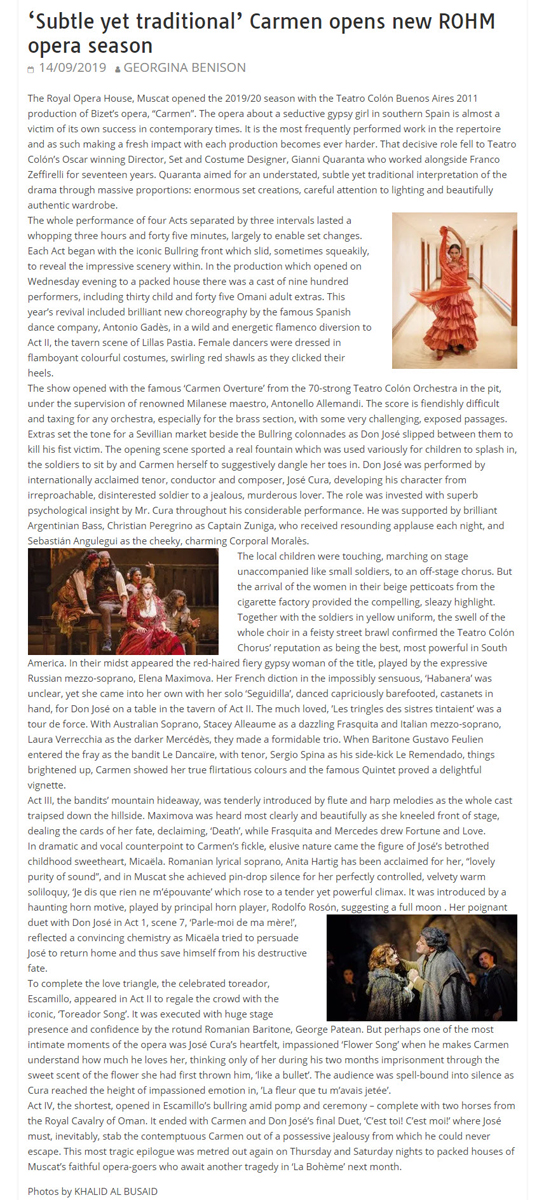 |
|

|
Read the full review on the web at the following URL:
Carmen, opera del célebre compositor francés George Bizet, posee música que el público en su mayoría reconoce, requiere en su generalidad gran escena como de un elevado número de participantes (hablamos entre solistas, coro, orquesta, figurantes, bailarines, más de 300 en esta ocasión). La Royal Opera House de Muscat, resolvió todo de manera monumental, esta reposición de la mencionada ópera (producción 2011), es la primera producción de Oriente Medio de la ópera de George Bizet, lo cual hace que sea un logro para la mencionada Institución. Carmen es la historia de una mujer gitana independiente que seduce a un sargento del ejército, Don José, al cual le advierte que no se enamore de ella y que claramente no es su tipo. Don José en cambio por su “obsesión” con ella, termina en la cárcel, luego de mostrar un perfil psicópata de asesino que finaliza en un salvaje crimen. El personaje de la sevillana del barrio de Triana, irá perdiendo interés en él “enamorándose” de un torero aventurero, Escamillo, el cual se adapta mucho mejor a ella. Don José dentro de su “obsesión “niega a dejarla ir matándola en una furia celosa. Dirigida por Gianni Quaranta, Carmen, inauguró la Temporada 2019/2020 del Primer Coliseo Omaní .Tuvo algunos aspectos destacados notables, como la brillante dirección del maestro milanés Antonello Allemandi , decoraciones realistas y ricas que transportaron a la audiencia a principios del siglo XIX a la Plaza de Toros de La Maestranza ( España). También vale la pena mencionar algunas actuaciones notables y una iluminación perfecta. La música es la clave para establecer el tono de una ópera, y Allemandi, que ha trabajado en los mejores teatros de ópera del mundo, es claramente un maestro, ya que logró liberar las emociones ideales y, a diferencia de la mayoría de los directores, nunca dejo que la orquesta domine a los cantantes. La mezzosoprano rusa Elena Maximova tomó la delantera como Carmen. Con el pelo castaño y largo y un descarado paseante, definitivamente parecía su rol. Durante el primer acto y medio, su energía brilló y retrató a una Carmen maravillosamente juguetona pero seductora, una mujer que sabe exactamente lo que quiere y cómo hacer que los hombres la adoren. Su voz con un centro extraño en definición, dio un crescendo rico mientras cantaba la famosa aria Habanera (“El amor es un pájaro rebelde”) en la que advierte a los hombres sobre su amor: “¡Si te amo, es mejor que tengas cuidado!”(dejo aclarado que este cronista asistió a las tres funciones, en donde pudo comprobarse una evolución vocal como escénica de dicha protagonista), no es una voz con amplio squilo, pero si dúctil en manejar matices. El papel de Don José fue interpretado por José Cura. Su hermosa voz robusta como brillante dio con una amplia gama de colores, siendo notable su fuerza como actor. Su Don José era débil e incapaz de resistir a una mujer cautivadora. Dejó que sus emociones obtuvieran lo mejor de sí mismo, y cuando perdió el control, arremetía, generalmente con un cuchillo. Cura parecía atormentado y frustrado, ¡un Don José perfecto! A medida que avanzaba la opera (salvo en el ultimo rendimiento) Maximova parecía perder el espíritu de Carmen y debilito un poco al personaje. Uno puede presuponer que quisiera mostrar un lado más vulnerable, lo cual atenuó su desempeño. La unión entre Maximova y Cura, fue ambivalente, Don José siempre en “defensa y ataque” fue mostrando habilidad para sacar el brutalismo de un ser desquiciado, frente a una Carmen que solamente se proyectaba en la unión carnal del deseo. Esto se vio en la escena final, donde Don José le suplica que lo amase nuevamente. Carmen se niega, y con una “carcajada fatal” elige la muerte para liberarse de él. La Orquesta Estable del Teatro Colón de Buenos Aires fue de un rendimiento ideal. El Coro Estable tuvo un fuerte desafío en la presente versión, pues debían interpretar de manera realista sin caer en lo absurdo y sumar el canto, pues mis estimados lectores, lo lograron absolutamente, me atrevo a decir luego de su rendimiento global que estamos ante el mejor Coro de América del Sur y de algunas regiones del mundo seguramente , lo cual entre la Orquesta , Coro y Solistas, da la pauta de una historia que vuelve al podio a la “Catedral de la Música” como otrora se lo denominaba al Teatro Colón emergiendo en esta gira por Oriente de manera superlativa. Lo cual llevo a la armonía absoluta en los impactantes escenarios, diseñados por Quaranta. En esta reposición 2019, pudo verse a la Compañía de Antonio Gades, que durante el II acto, realiza un zapateo flamenco con cruce, que da mayor dinámica a la escena, pero que resta en demasía la caja escénica ante tanta gente. Asimismo, es como que la acción pasa de la opera al musical en lapso rápido. Quisiera referirme a las voces que acompañaron a los dos protagonistas centrales. El bajo argentino Christian Pellegrino como el Capitán Zuniga, recibió un aplauso rotundo cada noche lo cual da pauta de su excelente trabajo vocal como actoral; Sebastián Angulegui como el descarado y encantador cabo Moralès fue correcto en su interpretación. La soprano australiana, Stacey Alleaume fué una deslumbrante Frasquita y la mezzosoprano italiana, Laura Verrecchia como la Mercédès más oscura, formaron un formidable trío junto a Maximova. Cuando el barítono Gustavo Feulien (argentino) entró en la refriega como el bandido Le Dancaïre junto al tenor, Sergio Spina (argentino) como Le Remendado, las cosas se animaron, Carmen mostró sus verdaderos colores coquetos y el famoso Quinteto demostró ser absolutamente ideal. En contrapunto dramático como vocal a la naturaleza voluble y evasiva de Carmen, apareció la figura de la prometida novia de José, Micaela. La soprano lírica rumana, Anita Hartig, de un “refinamiento vocal exquisito” logró en Muscat el silencio absoluto de la sala, una voz clara, de fraseo bello y de pianísimos bien terminados. Para completar el triángulo amoroso, el famoso torero, Escamillo, apareció en el Acto II en la célebre “Canción del torero”. Ejecutada con una fuerte impronta escénica por el barítono rumano George Petean, el cual emite sin problema alguno con claridad sus partes, pero es en su fisiqueé du rol y en su escaso margen escénico un escaso torero seductor, un problema que debió tenerse en cuenta dando marcaciones más abiertas y desplazamiento al célebre barítono. El momento de mayor emocion de las tres funciones fue la apasionada “La fleur que tu m’avais jetée” de José Cura cuando hace que Carmen comprenda cuánto la ama, “pensando/obsesionado” con ella durante sus dos meses de prisión a través del aroma de la flor que ella le arrojo. Los espectadores y el que les escribe sintió la emoción a piel. Ahora regresemos al marco escénico creado por el Mtro. Quaranta. El escenario estaba enmarcado por el antiguo edificio español de azulejos y yeso desgastado de la plaza de toros. La pared, se separa revelando las diversas escenas inspiradas en el pintor español Goya. Acto I, una plaza con una fuente de agua corriente, en la que soldados y transeúntes se mojan. Los tejados en su fondo parecían desvanecerse en la distancia. El acto II fue en el interior de una taberna, con mesas de madera y calidad paredes amarillas. Cuando los gitanos comienzan su baile, cambia la escena de la opera ay se transforma en un musical que es ahí en donde el público se puede llegar a identificar con el realismo cinematográfico de esta producción. Acto III una enorme ladera de montaña con un camino que conduce a las cuevas de los gitanos. Oscuro y misterioso, proporcionó el lugar perfecto para que Carmen prevea su muerte en las cartas del tarot. Las paredes circulares que abren y cierran los actos, se convirtieron en protagonistas del drama del acto final. Se abrieron para mostrar una plaza de toros con asientos y cuando las paredes se cerraron, formaron el exterior de la escena del crimen, la gente del pueblo mira hacia abajo la corrida de toros mientras afuera del muro el drama entre Carmen y Don José llega a su clímax. Los sets no solo dieron realismo, sino que reflejaron los estados de ánimo en cada acto. El iluminador A. J. Wiessbard transformó con su impronta la ópera en una película por su dinamismo. El cielo cambiaba constantemente, desde la luz del día hasta el anochecer. Lámparas y antorchas proporcionaban un ambiente romántico o un esplendor inquietante. La ROHM revisionó una producción de excelencia para la inauguración de su temporada 2019/2020. Pasión, locura y brillo fue su resultado, junto a un elenco de notables sumados a la brillante dirección de la Orquesta Estable del Teatro Colon por el Mtro. Antonello Allemandi y el Coro Estable (del histórico Teatro de Argentina) dirigido por el Mtro. Miguel Fabián Martínez. La ROHM, plantea una ubicación en el mundo de la lirica mundial de primer nivel, y con esta inauguración , en poco tiempo se consolidará dentro de los primeros Teatros Líricos del Mundo ante temporadas de excelencia como la que se acaba de inaugurar. By BATTAGLIA |
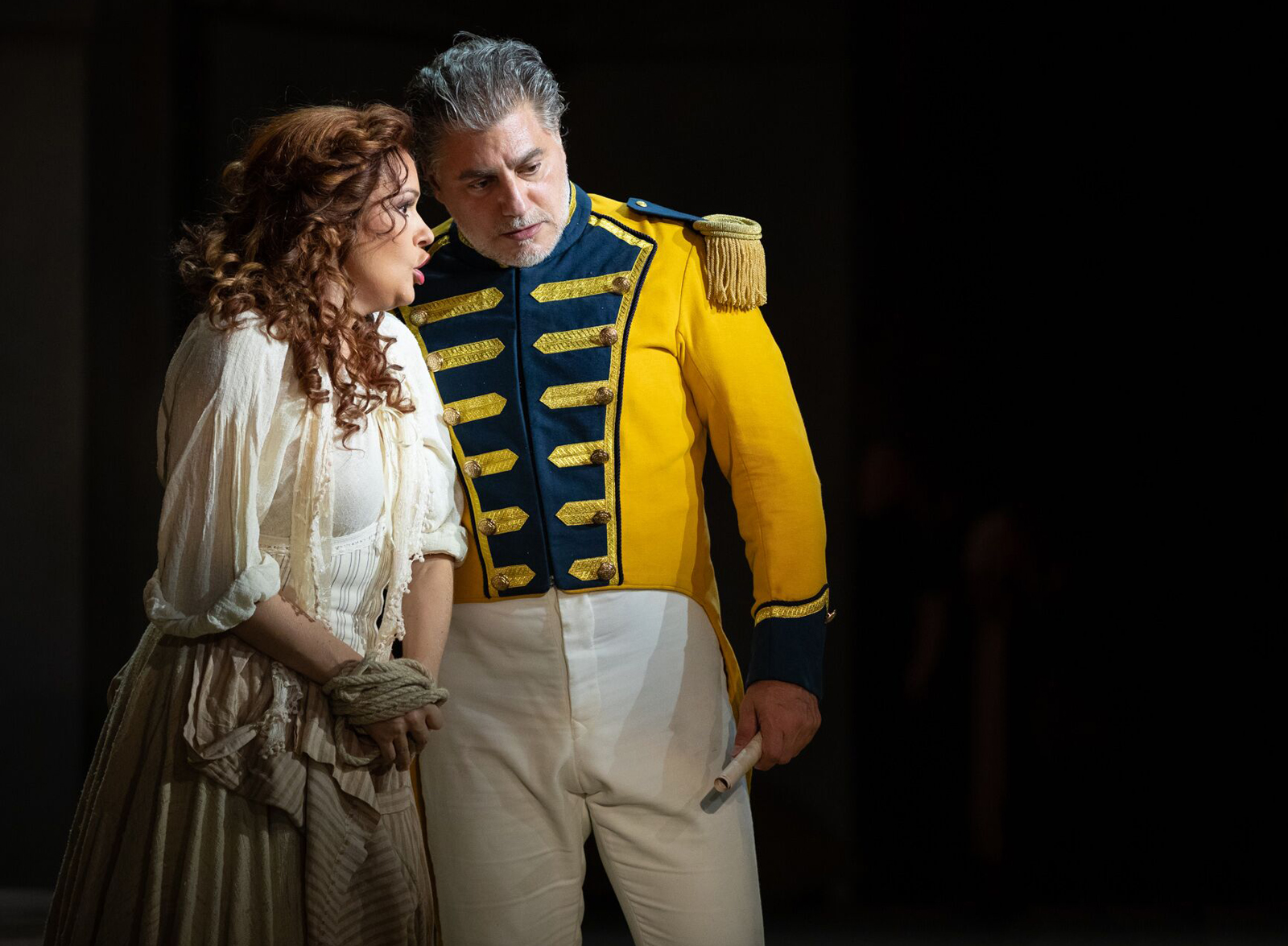
|
Note: This is a machine-based translation. We offer it only a a general guide but it should not be considered definitive.
Carmen (Bizet), Royal Opera House De Muscat, Teatro Colón de Buenos Aires
José Cura, Gianni Quaranta ... Memorable Version 15 September 2019 [Excerpts]
Directed by Gianni Quaranta, Carmen inaugurated the 2019/2020 Season of the First Omani Coliseum. It has some notable highlights, such as the brilliant conducting of the Milanese Maestro Antonello Allemandi and realistic and rich decorations that transported the audience the bullring of La Maestranza (Spain) at the beginning of the 19th century. It is also worth mentioning some notable performance and perfect lighting. […]
The role of Don José was played by José Cura. His beautiful voice, robust as well as brilliant, came with a wide range of colors but it was his strength as an actor that was remarkable. His Don Jose was weak and unable to resist a captivating woman. He let his emotions get the best of him and when he lost control, he would lash out, usually with a knife. Cura seemed tormented and frustrated, a perfect Don José! […] The moment of greatest emotion in each of the three performances came with José Cura’s passionate "La fleur que tu m'avais jetée" during which he makes Carmen understand how much he loves her, how he was "thinking/obsessed" with her during her two months in prison through the aroma of the flower she threw at him. The audience and this writer felt the emotion in the skin.
|
|
Most photos by Sergio Sosa Battaglia
|
|
Quick and dirty translation via computer....
Café con José Cura desde la Royal Opera House de Muscat By BATTAGLIA 10 September 2019
A majestic place, the Royal Opera House of Muscat, carried out the so-called "coffee" among the subscriber and referents of the Omani culture with the famous Argentine tenor José Cura. His interviewer was the General Director of the ROHM, Mr. Umberto Fanni. During the talk, which lasted about an hour, Cura commented on the beginnings of his career from his city of Rosario and Europe. His comments on the current opera and the new audiences mark a reality, the audiences will continue to come to see opera as to listen to pop music--probably no longer in traditional places but in outdoor places…the public is looking for modernity. Then he continued telling his activity as a composer to which he has recently dedicated his time, among his latest works is his oratory ECCE HOMO, a work of magnitude that was admired in the Müpa of Prague in 2016. It is divided into three parts being a symphonic piece where José Cura leaves the podium to take the role of Jesus in the final. It is a piece we hope to be able to hear soon in Argentina, for the quality and imprint with bravery that has its score of high demand both at the choral and instrumental level. He has also finish writing his opera Montezuma with a comic character. Cura discussed with the management when he was asked about the possibility of returning to the ROHM (remember that he had already played Pagliacci in last season) to play the role of Don José about the possibility of using the stable orchestra and choir of the Teatro Colón in Buenos Aires. Thus, the project was launched, a highly complex proposal and very difficult to see in any other theater in the world because of the costs. Likewise, the production was created especially for the ROHM from the famous director and designer Gianni Quarenta (winner of an Oscar for the production of A Window in Florence, film by James Ivory). Between Carmen's performance, which will be on September 11, 12 and 14, Cura will conduct the 9th Beethoven Symphony with soloists, choir and Stable Orchestra of the Teatro Colon de Buenos Aires. This was a milestone for the musical history of our First Colosseum, a tour that prestige the Colón and its member figures, which is an honor as an Argentine witness in a Theater that is emblem of the Sultanate of Oman, and that is a small jewel in the aridity that surrounds the city of Muscat.
|
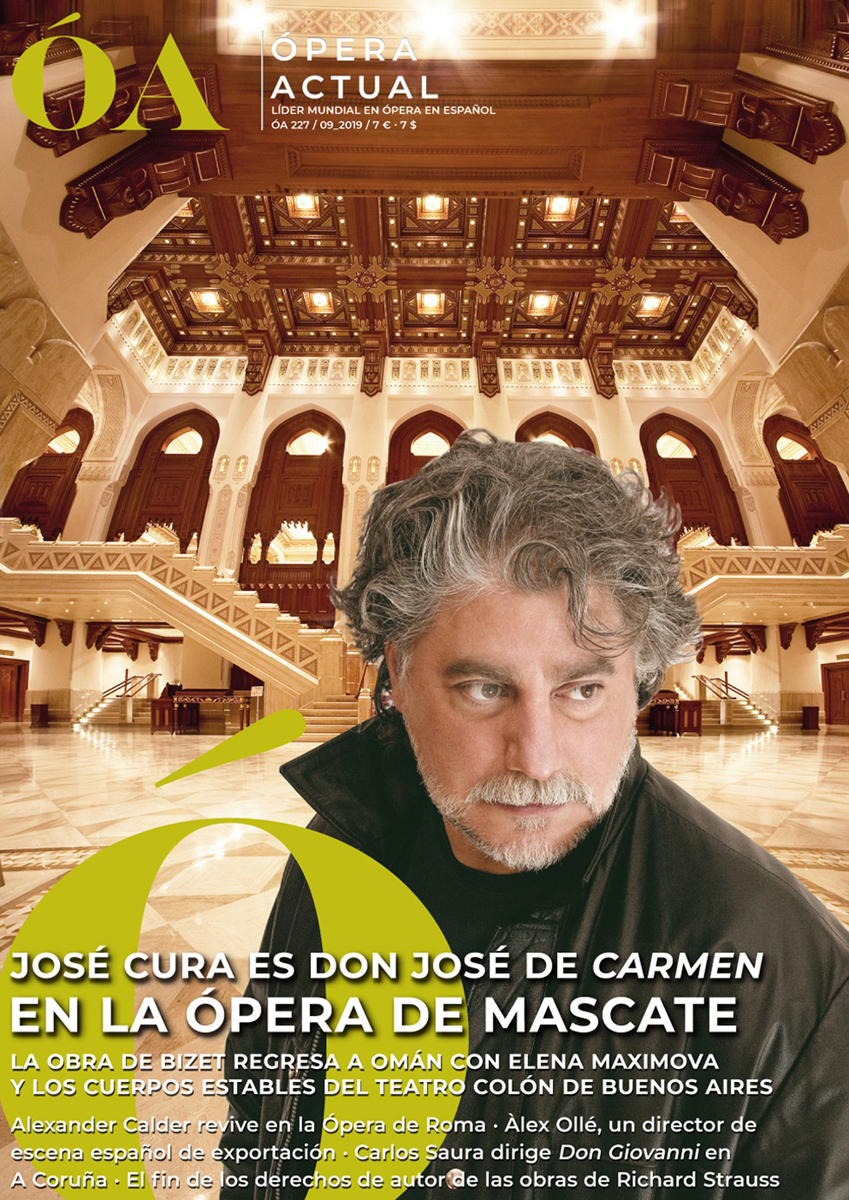
|
José Cura returns to the Royal Opera House of Muscat as Don José in Carmen
Ópera Actual Fernando Sans Rivière 01 September 2019
©
Zoe CURA © Zoe CURA© Zoe CURA The Argentine tenor returns to Oman between 11 and 14 September 2019, after his great success last season with Pagliacci. This time he will sing his iconic Don José in Carmen, along with mezzo Elena Maximova [Carmen], George Petean as Escamillo, Anita Hartig in the role of Micaëla and musical direction by Antonello Allemandi in charge of the Orchestra and Choir of the Theater Colon of Buenos Aires. For the Argentine tenor José Cura, it is both a great satisfaction and responsibility to participate in this Carmen, which will be offered alongside the Orchestra and Choir of the Teatro Colón from Buenos Aires. Ópera Actual: What do you think of the character of Don José and what do you remember about your debut [in the role]? José Cura: My relationship with Carmen dates back to the eighties when, as a young composer, I made a complete arrangement of the work to be presented in an hour and a half and with a mixed group of Spanish and symphonic instruments. As a singer I debuted in the role of Don José in 1996 in San Francisco, having as a partner Olga Borodina who was also debuting in the role of Carmen. We were both very young. OA: How has your character of Don José matured over the years and what do you think is your personal contribution? JC: There is a basic confusion about Don José Lizarrabengoa, born of the beautiful but unrealistic French reading of a Spanish subject. In Carmen, the radically opposite psychologies of the introverted Basque and the carefree Andalusian face off in a clash of cultures that, even today, are the subject of television series and films such as Eight Basque surnames, for example. Despite this de facto fact, Carmen develops into an almost a caricature of the Andalusian personality of the female protagonist, confining José's interpretation to that of a silly half-dummy, of childish behavior, almost capricious. José is young, but the boy's freshness has long since ceased and has transformed into a shock-induced maturity. To understand, let's compare the adolescence of a middle-class Western boy with that of one born and raised in Syria under the sign of the bombs ... Don José killed two friends because of an argument over a game and then, to escape justice, he enrolled in the army where he was protected by the martial law of the time. Even as a soldier he is a time bomb. The first time a superior humiliates him, he explodes with unpredictable consequences. Someone with such psychosocial instability is then crossed by a sensual, elusive and fatal woman - fatal in the etymological sense of the word, linked to destiny - like Carmen, who is more amused with deflowering him than in truly loving him. Let’s not forget that in the repressive literature of the nineteenth century the word love did not necessarily represent feeling as such but was a euphemism of sex. It is a euphemism that, a little by modesty and so much by habit, we continue to use today in that we “make” love instead of "feeling it”... I try to reconcile respect for the French style, singing in a rather demure way the first two acts, gradually releasing the sullenness as the third act progresses, and then move from the pathos of one who begs to be loved to the wild hatred of one who has been rejected in humiliating ways. Humiliation: here is the keyword. José doesn't kill Carmen because she rejects him. This was fixed with the umpteenth discussion. José kills Carmen for the same reason that he killed those two guys at the beginning of his life journey, and for the same reason that, in the novel, he kills one of his officers and also Carmen's husband, one-eyed Garcia: because they humiliated him in public! This raw reading is, in my opinion and after more than 30 years of relationship with the work, the only way to make the best of two worlds that are musically and culturally opposed, as French and Spanish, in the light of a modern interpretation, without mannerism, of this magnificent work. OA: You have already sung Pagliacci in Oman. What do you think of the Theater and the country? JC: Muscat is a pleasant city, without skyscrapers, where the buildings are white to minimize the effect of the sun inside the houses. The contrast between the new, but traditional architecture, and the soft, sandy colors, against a perennially blue sky and a wonderful sea, gives a sense of great peace. That, if the heat is endured! On the other hand, Oman is a clear example of intercultural and interreligious tolerance. People, always with caution, can go around dressed as Europeans without fear and even wear crosses around their neck. There are even churches of other religions. And ROHM is a mirror of all this: an effective theater to the extreme, of a beautiful architecture in which one works with great artistic and logistical serenity. OA: What does it mean to travel to Oman with the Orchestra and Choir of your homeland? JC: When I was asked with which theater I’d like to return to Oman after the success of Pagliacci, I didn't hesitate for a second. I am myself acting as liaison and negotiator between the two administrations. With tenacity and professionalism an agreement has been drawn that will set an undisputed precedent for the exemplary nature of the great Argentine coliseum when it comes to serving as our country’s ambassador abroad. OA: Do you know Gianni Quaranta’s stage proposal? JC: I've seen photos and videos. It is a serious staging and respectful of the work, in which the artistic bodies of the Teatro Colón and the cast of international soloists, together with the Antonio Gades Ballet, will be very comfortable. OA: You will also conduct Beethoven’s Ninth Symphony in Oman with the Colón’s Orchestra and Choir. JC: Yes, it is the Beethoven work that I have conducted most. My return to the orchestra direction and composition are consolidating naturally in my career as, by the law of life, as a singer I reduce performances. I have finished my contract with the Prague Symphony and have just signed as the main guest artist of the Hungarian Radio. With them we will do, among other things, the recording of my Ecce Homo oratory, the world premiere in concert form of my opera Montezuma and the Red Priest and, in 2022, the world premiere of my Argentine Requiem for which I would love to have the Colón’s Choir. OA: What operas do you have programmed as a stage director? JC: In 2018 I directed and starred Peter Grimes in Bonn and Monte-Carlo, Nabucco in the Prague Opera and La fanciulla in the Tallinn. In 2019 I hope to finish my opera as mentioned above and I will return to stage direction in 2020 with a new production of Otello.
|
|
|
Last Updated: Friday, September 27, 2019 © Copyright: Kira